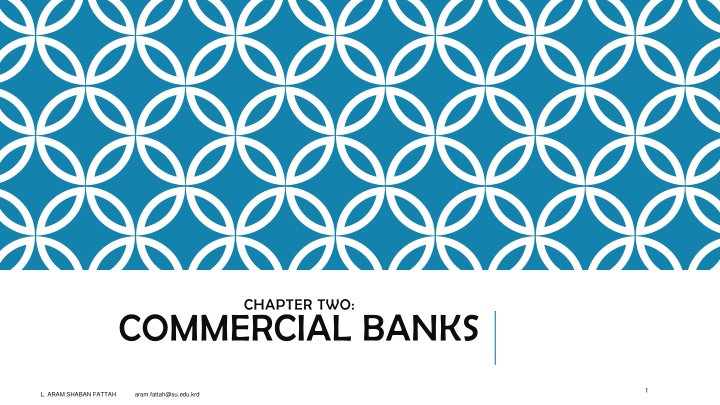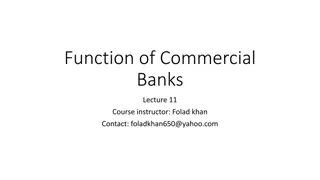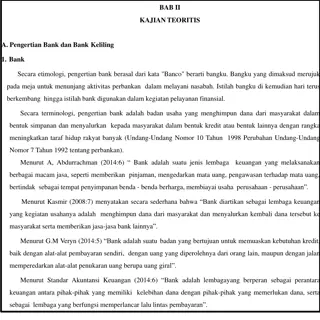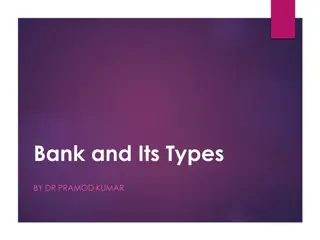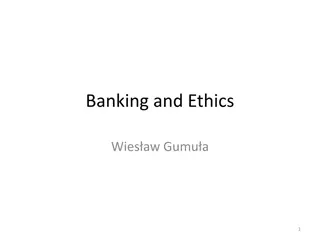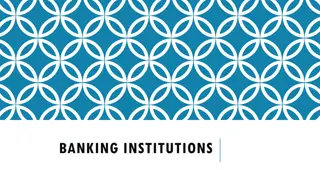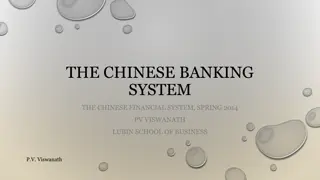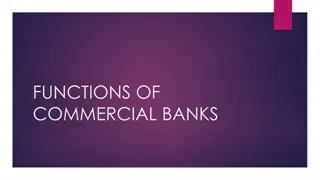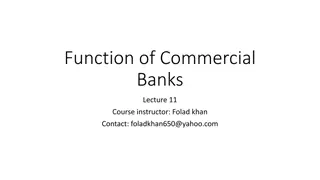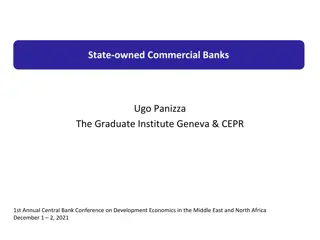Types of Commercial Banks and Their Functions
Commercial banks play a crucial role in the financial system by providing various services such as loans, deposits, and financial transfers. This chapter explores different types of commercial banks including private, public, and foreign banks, highlighting their unique characteristics and functions. Understanding these distinctions is essential for grasping the diverse landscape of commercial banking.
Download Presentation

Please find below an Image/Link to download the presentation.
The content on the website is provided AS IS for your information and personal use only. It may not be sold, licensed, or shared on other websites without obtaining consent from the author.If you encounter any issues during the download, it is possible that the publisher has removed the file from their server.
You are allowed to download the files provided on this website for personal or commercial use, subject to the condition that they are used lawfully. All files are the property of their respective owners.
The content on the website is provided AS IS for your information and personal use only. It may not be sold, licensed, or shared on other websites without obtaining consent from the author.
E N D
Presentation Transcript
CHAPTER TWO: COMMERCIAL BANKS 1 L. ARAM SHABAN FATTAH aram.fattah@su.edu.krd
LEARNING OUTCOMES After studying this chapter , you will able to: Define Commercial Banks Getting Information About; Types Of Commercial Banks, Functions of Commercial Banks L. ARAM SHABAN FATTAH aram.fattah@su.edu.krd 2
WHAT ARE COMMERCIAL BANKS? Commercial banks are the most important components of the whole banking system. A commercial bank, (Deposit bank) is a profit- based/seeking financial institution that grants loans, accepts deposits, and offers other financial services, such as overdraft facilities and electronic transfer of funds. In other words, commercial banks are financial institutions that accept deposits from the general public (surplus units), transfer funds from the bank to another (deficit units), and earn profit. L. ARAM SHABAN FATTAH aram.fattah@su.edu.krd 3
WHAT ARE COMMERCIAL BANKS? Commercial Banks mostly offer short-term and medium-term loans from a percentage of the cash deposits at a high interest rate. They do not provide long-term financing due to the need to maintain liquidity of assets. The funds of commercial banks belong to the general public and are withdrawn at a short notice; therefore, commercial banks prefers to provide credit for a short period of time backed by tangible and easily marketable securities. Commercial banks, while providing loans to businesses, consider various factors, such as nature and size of business, financial status and profitability of the business, and its ability to repay loans. L. ARAM SHABAN FATTAH aram.fattah@su.edu.krd 4
TYPES OF COMMERCIAL BANKS There are three different types of commercial bank. Private Bank It is one type of commercial banks where private individuals and businesses own a majority of the share capital (the private individuals own more than 51% of the share capital). All private banks are recorded as companies with limited liability. Such as RT Bank , Babylon Bank, Ashur International Bank, Morgan Stanley etc. Public Bank It is those type of bank that is nationalized, and the government holds a significant stake (the Government holds more than 51% of the share capital). For example, Trade Bank of Iraq, Rafidain Bank, Rasheed Bank. Foreign Bank These banks are established in foreign countries and have branches in other countries. For instance, American Express Bank, Hong Kong and Shanghai Banking Corporation (HSBC), Standard & Chartered Bank, and Citibank etc. 5 L. ARAM SHABAN FATTAH aram.fattah@su.edu.krd
CORPORATE VS. RETAIL BANKING RETAIL BANKING Comparison CORPORATE BANKING Definition Retail Banking is a banking service provided to the general public or individual. Corporate banking is a commercial banking facility which only deals with small or large companies and corporate bodies. Products Customers are the focus of retail banking products. Corporate banking services are focused on the needs of businesses. Clientele The clientele of retail banking is extensive. The customer of corporate banking is rather limited. Processing cost Low Comparatively High Transactions Lower value of transactions Handling fees in business banking are greater than in retail banking. Charges Handling fees in retail banking are minimal. Handling fees in business banking are greater than in retail banking 6
FUNCTIONS OF COMMERCIAL BANKS L. ARAM SHABAN FATTAH aram.fattah@su.edu.krd 7
WHAT IS BANK DEPOSIT Money saved in Iraqi Dinar/foreign currency by real and legal persons in banks or authorized institutions, to be withdrawn at any time or at the end of a certain maturity, is called "deposit". There are two main reasons for people or institutions to deposit their money in banks. These are; to generating income or keeping their money safe. 8 L. ARAM SHABAN FATTAH aram.fattah@su.edu.krd
PRIMARY FUNCTIONS OF COMMERCIAL BANKS -Also known as demand deposits. These deposits can be withdrawn at any time. -No interest is allowed on it. -The customer is required to leave a minimum balance undrawn with the bank -Cheques are used to withdraw Current Deposits -Fixed deposits have a fixed period of maturity and are referred to as time deposits. -They can be withdrawn only after the maturity of the specified fixed period. -The interest rates are higher in case of such deposits. -in practice banks allow the depositors to withdraw funds. even before the maturity period but at a low interest (or without paying interest rate). 1. Acceptance of Deposits Fixed Deposits The traditional commercial bank is to accept deposits from the public. Deposits may be of three types: most important place and -It is most suitable term of deposit for individual households. -They combine the features of both current account and fixed. payable on demand and also by cheque. -But bank gives this facility with some restrictions. -Interest paid on savings account deposits in lesser than that of fixed deposit. for a Savings Deposits L. ARAM SHABAN FATTAH aram.fattah@su.edu.krd 9
DIFFERENCE BETWEEN DEMAND DEPOSITS AND FIXED DEPOSITS DEMAND DEPOSITS (ACCOUNTS) FIXED DEPOSITS (ACCOUNTS) These deposits can be withdrawn at any time. They can be withdrawn only after the maturity of the specified fixed period. No interest is allowed on it. Specific interest rate allowed on it. (carry a fixed rate of interest.) Cheques are used to withdraw Cheques aren t used to withdraw Are highly liquid Are less liquid L. ARAM SHABAN FATTAH ARAM.FATTAH@SU.EDU.KRD 10
PRIMARY FUNCTIONS OF COMMERCIAL BANKS 2.Advancing Loans -Advances to all types of persons, particularly to businessmen and entrepreneurs. -Loans are made against personal security. e.g; gold and silver, stocks and other assets. The bank advances a cash loan up to a specified limit to the customer against an security/asset. In other words, Cash Credit (CC) is a short-term source of financing for a company. In other words, a cash credit is a short- term loan extended to a company by a bank. (b) Cash Credit A term loan is a type of advance that comes with a fixed duration for repayment, a fixed amount as loan, a repayment schedule as well as a pre- determined interest rate. A borrower can opt for a fixed or floating rate of interest for repayment of the advance. (e) Term Loans Consumer credit is personal debt taken on to purchase goods and services. A credit card is one form of consumer credit. the bank pays the amount of bill presented by the customer after deducting the usual bank discount. -Bank also grant loans for a very short period, generally not exceeding 7 days to the borrowers. A borrower is allowed to withdraw more amount than what he has deposited. (c) Discounting Bills of Exchange (f) Consumer Credit (d) Money at Call (a) Overdraft L. ARAM SHABAN FATTAH aram.fattah@su.edu.krd 11
THE DIFFERENCES BETWEEN CASH CREDIT & OVERDRAFT Cash Credit The interest rate is lower as compared to Overdraft Overdraft The interest rate is comparatively higher Overdraft amount can be availed based on credit history, relationship with the bank, and investments like FDs, insurance policies, etc. An overdraft can be used for any purpose, including business-related requirements The loan amount is based on financial statements and security deposit Cash credit loan can be availed on hypothecation of stocks and inventory Cash Credit should be availed for business purposes, only The loan amount is based on the volume of stocks and inventory To avail Cash Credit, a new account needs to be openedOverdraft facility is availed on the existing account of the applicant (account holder) An overdraft facility can be availed for shorter tenure like a month or quarter, maximum of 1 year Cash credit loan can be availed for a minimum 1 year Cash credit loans can be availed by individuals, retailers, traders, manufacturers, distributors, companies, partnerships, sole proprietorships, etc. An overdraft facility can only be availed by account holders of the respective bank L. ARAM SHABAN FATTAH aram.fattah@su.edu.krd 12
PRIMARY FUNCTIONS OF COMMERCIAL BANKS 3. Creation of Credit: A unique function of the bank is to create credit. Banks supply money to traders and manufacturers. They also create or manufacture money. Bank deposits are regarded as money. They are as good as cash. The reason is they can be used for the purchase of goods and services and also in payment of debts. When a bank grants a loan to its customer, it does not pay cash. It simply credits the account of the borrower**. He can withdraw the amount whenever he wants by a cheque. In this case, bank has created a deposit without receiving cash. That is, banks are said to have created credit. Sayers says banks are not merely purveyors of money, but also in an important sense, manufacturers of money. 13
MEASURES MONEY SUPPLY Money Supply Type M0 M1 Currency in Circulation + Banks Deposits with Central Bank. M0 + Demand deposits with the Banking system (current account) + Other Checkable Deposits. M1 + Small denomination Time Deposits (Saving Accounts) (amounts of less than $100,000)+ Money Market Mutual funds held by individuals (such as U.S. Treasuries) M2 + Large denomination Time Deposits (Fixed Account) (amounts of more than $100,000) + Money market funds held by institutions (Such as Repo). M2 M3 The money supply; is the total amount cash, coins, and balances in bank circulation. of money; accounts in 14
MONEY CREATION BY COMMERCIAL BANKS Chairman of the United States Federal Reserve February 1, 2006 January 31, 2014 L. ARAM SHABAN FATTAH aram.fattah@su.edu.krd 15
L. ARAM SHABAN FATTAH aram.fattah@su.edu.krd 16
L. ARAM SHABAN FATTAH aram.fattah@su.edu.krd 17
3. CREATION OF CREDIT CONT. (a) (1) Lets assume that the entire commercial banking system is one unit. Let us call this one unit simply commercial banks . (2) Lets also assume that all receipts and payments in the economy are routed through the commercial banks. (3) Customer who makes payment does it by writing cheque. The customer who receives payment, deposits the same amount in his/her deposit account. (b) Suppose initially people deposit $1000. The commercial banks use this money for giving loans. But the commercial banks cannot use the whole of deposit for this purpose. It is legally compulsory for the banks to keep a certain minimum fraction of these deposits as cash. The fraction is called the Required Reserve Ratio (rr). The (rr) is fixed by the Central Bank. (c) Suppose the initial deposits in banks is $1000 and the (rr) is 10%. Further, suppose that commercial banks keep only the minimum required, i.e., $100 as cash reserve, commercial banks are now free to lend the remainder $900. Suppose they lend $900. What banks do to open deposit accounts in the names of the borrowers who are free to withdraw the amount whenever they like. Suppose they withdraw the whole of amount for making payments. L. ARAM SHABAN FATTAH aram.fattah@su.edu.krd 18
3. CREATION OF CREDIT CONT. (d) Now, since all the transactions are routed through the commercial banks, the money spent by the borrowers comes back into the banks into the deposit accounts of those who have received this payment. This increases demand deposit in banks by $900. It is 90% of the initial deposit. These deposits of $900 have resulted on account of loans given by the banks. In this sense the banks are responsible for money creation. With this round, increased in total deposits are now $1900 (=$1000 + $900). (e) When banks receive new deposit of $900, they keep 10% of it as required reserves and use the remaining $810 for giving loans. The borrowers use these loans for making payments. The money comes back into the accounts of those who have received the payments. Bank deposits again rise, but by a smaller amount of $810. It is 90% of the last deposit creation. The total deposits now increase to $2710 (=$1000 + $900 + $810). The process does not end here. (f) The deposit creation continues in the above manner. The deposits go on increasing round after round but Deposit Creation By Commercial Banks each time only 90% of the last round deposits. At the same time cash reserves go on increasing, each time 90% of the last required reserve. *The deposit creation comes to end when the total require reserves become equal to the initial deposit. The total deposit creation comes to $10,000 (ten times the initial deposit) as shown in the table. 19
3. CREATION OF CREDIT CONT. Money (Credit) Creation By Commercial Banks Required Reserves (rr= 0.1) $ Rounds Deposits $ Loans $ It can also be explained with the help of the following formula: Money Multiplier= 1/rr = 1 / 0.1= 10 Thus, the total money creation is; Money Creation= Initial Deposit * 1/rr = $10,000 Initial 1,000 900 100 Round 1 900 810 90 Round 2 810 729 81 - - - - - - - - - - - - Total 10,000 9,000 1,000 L. ARAM SHABAN FATTAH aram.fattah@su.edu.krd 20
3. CREATION OF CREDIT CONT. Banks are required to keep only a fraction of deposits as cash reserves because of the following two reasons: (a) First, the banking experience has revealed that not all depositors approach the banks for withdrawal of money at the same time and also that normally they withdraw a fraction of deposits. (b) Secondly, there is a constant flow of new deposits into the banks. Therefore to meet the daily demand for withdrawal of cash, it is sufficient for banks to keep only a fraction of deposits as a cash reserve. 21
PRIMARY FUNCTIONS OF COMMERCIAL BANKS 4. Promote the Use of Cheques: The commercial banks render an important service by providing to their customers a cheap medium of exchange like cheques. It is found much more convenient to settle debts through cheques rather than through the use of cash. The cheque is the most developed type of credit instrument in the money market. L. ARAM SHABAN FATTAH aram.fattah@su.edu.krd 22
PRIMARY FUNCTIONS OF COMMERCIAL BANKS 5. Financing Internal and Foreign Trade: The bank finances internal and foreign trade through discounting of exchange bills. Sometimes, the bank gives short-term loans to traders on the security of commercial papers. business greatly facilitates the movement of internal and external trade. This discounting Banks issue Letter of Credit for traders. L. ARAM SHABAN FATTAH aram.fattah@su.edu.krd 23
PRIMARY FUNCTIONS OF COMMERCIAL BANKS 6. Transfer of Funds: Commercial banks, on account of their network of branches throughout the country, also provide facilities to remit funds from one place to another for their customers by issuing bank drafts, mail transfers or telegraphic transfers on nominal commission charges. As compared to the postal money orders or other instruments, bank drafts have proved to be a much cheaper mode of transferring money and has helped the business community considerably. L. ARAM SHABAN FATTAH aram.fattah@su.edu.krd 24
SECONDARY FUNCTIONS OF COMMERCIAL BANKS SECONDARY FUNCTIONS GENERAL UTILITY SERVICES AGENCY SERVICES L. ARAM SHABAN FATTAH aram.fattah@su.edu.krd 25
SECONDARY FUNCTIONS OF COMMERCIAL BANKS 1. Agency Services: Banks also perform certain agency functions for and on behalf of their customers. The agency services are of immense value to the people at large. The various agency services rendered by banks are as follows: (a) Collection and Payment of Credit Instruments: Banks collect and pay various credit instruments like cheques, bills of exchange, promissory notes etc., on behalf of their customers. (b) Purchase and Sale of Securities: Banks purchase and sell various securities like shares, stocks, bonds, debentures on behalf of their customers. (c) Collection of Dividends on Shares: Banks collect dividends and interest on shares and debentures of their customers and credit them to their accounts. L. ARAM SHABAN FATTAH aram.fattah@su.edu.krd 26
SECONDARY FUNCTIONS OF COMMERCIAL BANKS 1. Agency Services (d) Acts as Correspondent: Sometimes banks act as representative and correspondents of their customers. They get passports, travelers' tickets and even secure air and sea passages for their customers. (e) Income-tax Consultancy: Banks may also employ income tax experts to prepare income tax returns for their customers and to help them to get refund of income tax. (f) Execution of Standing Orders: Banks execute the standing instructions of their customers for making various periodic payments. They pay subscriptions, rents, insurance premia etc., on behalf of their customers. (g) Acts as Trustee and Executor: Banks preserve the Wills of their customers and execute them after their death. L. ARAM SHABAN FATTAH aram.fattah@su.edu.krd 27
SECONDARY FUNCTIONS OF COMMERCIAL BANKS 2. General Utility Services: In addition to agency services, the modern banks provide many general utility services for the community as given. (a) Locker Facility: Bank provide locker facility to their customers. The customers can keep their valuables, such as gold and silver ornaments, important documents; shares and debentures in these lockers for safe custody. (b) Travelers' Cheques and Credit Cards: Banks issue travelers' cheques to help their customers to travel without the fear of theft or loss of money. With this facility, the customers need not take the risk of carrying cash with them during their travels. (c) Letter of Credit: Letters of credit are issued by the banks to their customers certifying their credit worthiness. Letters of credit are very useful in foreign trade. (d) Collection of Statistics: Banks collect statistics giving important information relating to trade, commerce, industries, money and banking. They also publish valuable journals and bulletins containing articles on economic and financial matters. L. ARAM SHABAN FATTAH aram.fattah@su.edu.krd 28
Thank you 29
